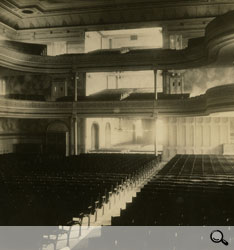

“[Steinway Hall] Inauguration Concert by the Bateman Concert troupe. Everybody is delighted with the acoustic qualities. House filled to overflowing. Great Success.” —October 31, 1866, Diary Volume One
Steinway & Sons: Promotional Prowess
Over the course of William’s lifetime, Steinway & Sons rose
from humble beginnings in Lower Manhattan to international
renown. Several important patents—including one for crossstringing
grand pianos on a single-piece cast-iron frame—gained
the firm acclaim. Its introduction of the modern grand piano’s
powerful tone won a gold medal at the 1867 Paris Exposition
and established Steinway & Sons and American manufacturers as
industry leaders. These achievements, combined with William’s
promotional acumen, allowed Steinway & Sons to grow in
prominence. Newspapers, magazines, trade catalogs, and concert
programs heralded prizes for richness of sound and technical
innovation. Expanded, more efficient factories and showrooms
were lauded and illustrated in exquisite detail. Steinway Hall
performances by Steinway-sponsored virtuosos playing Steinway
pianos were celebrated.
Guided by William’s vision, Steinway & Sons fed the period’s
ravenous musical appetite with Steinway Hall, a state-of-the
art performance space connected to its East 14th Street piano
showroom. During its existence, thousands of performances
were held in an opulent 2,000-seat space. Russian pianist
Anton Rubinstein’s 1871 American debut and other sell-out
performances reinforced the public’s association of Steinway Hall
and Steinway & Sons with musical excellence.
“Steinway & Son’s [sic] New Piano Forte Salerooms Nº 71 & 73 East 14th St,”
From Frank Leslie’s Illustrated Newspaper, May 28, 1864
Courtesy of Henry Z. Steinway Archive
Steinway Hall interior, about 1866
Photographer unknown, New York City
From Collection 178, Steinway & Sons Records and Family Papers, 1857–1919,
Archives Center, National Museum of American History


